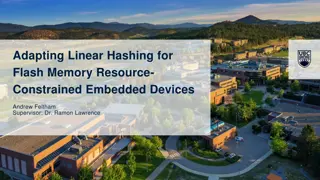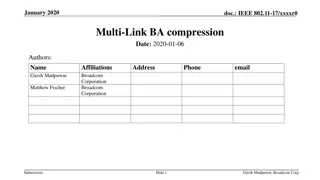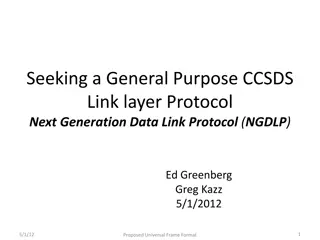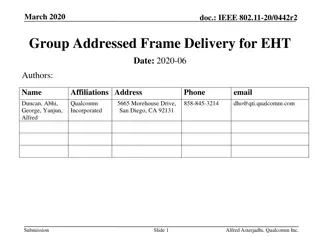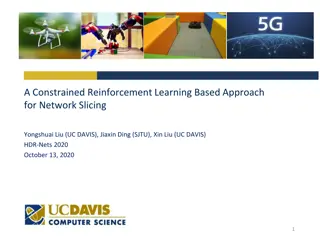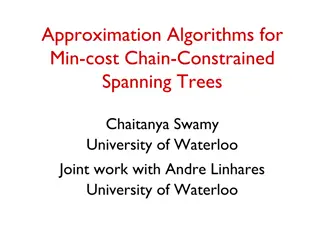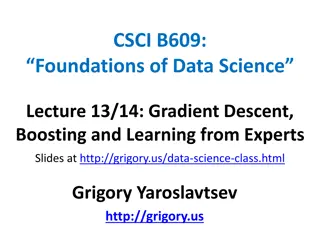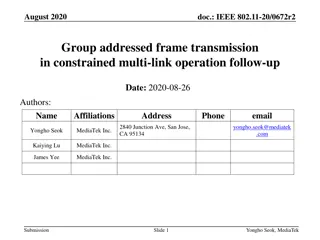
Group Addressed Frame Transmission in Constrained Multi-Link Operation
Explore how constrained Multi-Link Devices (MLDs) can efficiently transmit group addressed frames while avoiding interference in multi-link operations. The article delves into the IEEE 802.11 standards and the challenges of transmitting frames on multiple links simultaneously.
Uploaded on | 1 Views
Download Presentation

Please find below an Image/Link to download the presentation.
The content on the website is provided AS IS for your information and personal use only. It may not be sold, licensed, or shared on other websites without obtaining consent from the author. If you encounter any issues during the download, it is possible that the publisher has removed the file from their server.
You are allowed to download the files provided on this website for personal or commercial use, subject to the condition that they are used lawfully. All files are the property of their respective owners.
The content on the website is provided AS IS for your information and personal use only. It may not be sold, licensed, or shared on other websites without obtaining consent from the author.
E N D
Presentation Transcript
January 2020 doc.: IEEE 802.11-20/0329r4 Group addressed frame transmission in constrained multi-link operation Date: 2020-04-17 Authors: Name Affiliations Address Phone email 2840 Junction Ave, San Jose, CA 95134 yongho.seok@mediatek .com Yongho Seok MediaTek Inc. Kaiying Lu MediaTek Inc. James Yee MediaTek Inc. Submission Slide 1 Yongho Seok, MediaTek
January 2020 doc.: IEEE 802.11-20/0329r4 Recap: Constrained Multi-Link Device (MLD) A constrained MLD is a MLD with which in-device coexistence (IDC) interference occurs when more than one STA within the MLD simultaneously transmits and receives frames on multiple links. When simultaneous Tx and Rx occur on 2.4 GHz band and 5 GHz links, the IDC interference is probably negligible. But, the IDC interference caused by simultaneous Tx and Rx on 5 GHz band and 6 GHz band links may be significantly worse depending on some implementation factors such as RF filter performance. Submission Slide 2 Yongho Seok, MediaTek
January 2020 doc.: IEEE 802.11-20/0329r4 Motivation It is necessary that a constrained MLD avoids transmitting and receiving frames on multiple links simultaneously. This contribution discuss a reliable group addressed frame transmission to a constrained MLD. Submission Slide 3 Yongho Seok, MediaTek
January 2020 Group addressed frame transmission in constrained multi-link operation doc.: IEEE 802.11-20/0329r4 In order to reliably deliver a group addressed frame to a constrained non-AP MLD, an AP MLD should not schedule to the non-AP MLD a frame exchange sequence which overlaps with the group addressed frame of other link(s). Interference leakage from STA2 DTIM Beacon (Rx) Group addressed frame (Rx) STA1 in Non-AP MLD Block Ack (Tx) STA2 in Non-AP MLD Individually addressed frame (Rx) Submission Slide 4 Yongho Seok, MediaTek
January 2020 Group addressed frame transmission in constrained multi-link operation doc.: IEEE 802.11-20/0329r4 If the AP MLD does not know the link(s) on which the non-AP MLD is listening the group addressed frame, the AP MLD should not schedule to the non-AP MLD any frame exchange sequence which overlaps with the group addressed frame of other link(s). D D AP1 in AP MLD D D AP2 in AP MLD D D AP3 in AP MLD During this time, the AP does not schedule to the non-AP MLD any frame exchange sequence. Submission Slide 5 Yongho Seok, MediaTek
January 2020 Group addressed frame transmission in constrained multi-link operation doc.: IEEE 802.11-20/0329r4 In order to improve an efficiency of the multi-link operation, the non-AP MLD should configure to the AP MLD the link(s) on which it is listening the group addressed frame. Then, the AP MLD should not schedule to the non-AP MLD a frame exchange sequence which overlaps with the group addressed frame of the configured link(s). Submission Slide 6 Yongho Seok, MediaTek
January 2020 Group addressed frame transmission in constrained multi-link operation doc.: IEEE 802.11-20/0329r4 Also, when a non-AP MLD intends to receive the group addressed frame on the configured link, other STAs in the non-AP MLD, which can't simultaneously transmit and receive with the STA in the non-AP MLD which is configured to receive the group addressed frames, shall not access a channel during the group addressed frame transmission time. Submission Slide 7 Yongho Seok, MediaTek
January 2020 Group addressed frame transmission in constrained multi-link operation doc.: IEEE 802.11-20/0329r4 As in the below figure, the constrained non-AP MLD does not access the channel during the group addressed frame transmission time of the configured link. But, at the group addressed frame transmission time of other links, the non-AP MLD can access the channel. L1 STA in AP MLD DTIM beacon Group addressed MPDU BA L2 STA in AP MLD DTIM beacon Group addressed MPDU Channel access from non-AP MLD is not allowed L1 STA in non-AP MLD1 A-MPDU (to AP MLD) L2 STA in non-AP MLD1 Channel access from non-AP MLD is not allowed Channel access from non-AP MLD is not allowed L1 STA in non-AP MLD2 L2 STA in non-AP MLD2 Channel access from non-AP MLD is not allowed Submission Slide 8 Yongho Seok, MediaTek
January 2020 doc.: IEEE 802.11-20/0329r4 Conclusion For a reliable group addressed frame transmission to a constrained MLD, The constrained non-AP MLD needs to configure to the AP MLD the link(s) on which it is listening the group addressed frame. The AP MLD should not schedule to the non-AP MLD a frame exchange sequence which overlaps with the group addressed frame of the configured link(s). The non-AP MLD intends to receive the group addressed frame shall not access a channel during the group addressed frame transmission time on the configured link(s). Submission Slide 9 Yongho Seok, MediaTek
January 2020 doc.: IEEE 802.11-20/0329r4 Straw Poll 1 Do you support the following group addressed frames delivery mechanism? The non-STR STA MLD may configure one link with the AP MLD to receive group addressed frames, then during the group addressed delivery in the configured link, then the AP MLD may not schedule frames soliciting an immediate response to this non- STR STA MLD on other links that overlap with group address frame. NOTE- The condition to signal the configured link is TBD. Yes/No/Abstain/No Answer: 36/21/35/14 (Failed) Submission Slide 10 Yongho Seok, MediaTek
January 2020 doc.: IEEE 802.11-20/0329r4 Straw Poll 2 Do you support the following group addressed frames delivery mechanism? The non-STR non-AP MLD may configure one link with the AP MLD to receive group addressed frames, then during the group addressed delivery in the configured link, then the AP MLD and non-STR non-AP MLD may not schedule frames soliciting an immediate response to each other on other links that overlap with the group address frames. NOTE- The condition to signal the configured link is TBD. NOTE- The condition to configure more than one links to receive group addressed frames (e.g., GCR) is TBD. Submission Slide 11 Yongho Seok, MediaTek



